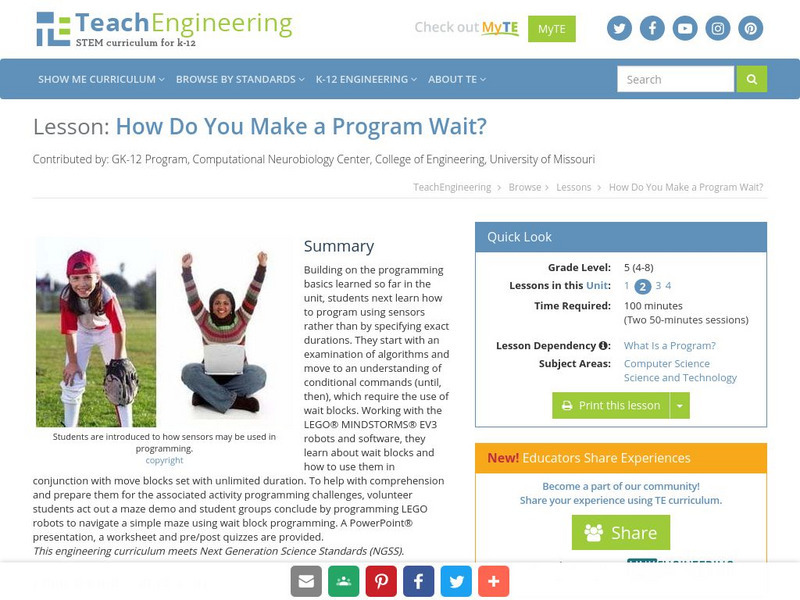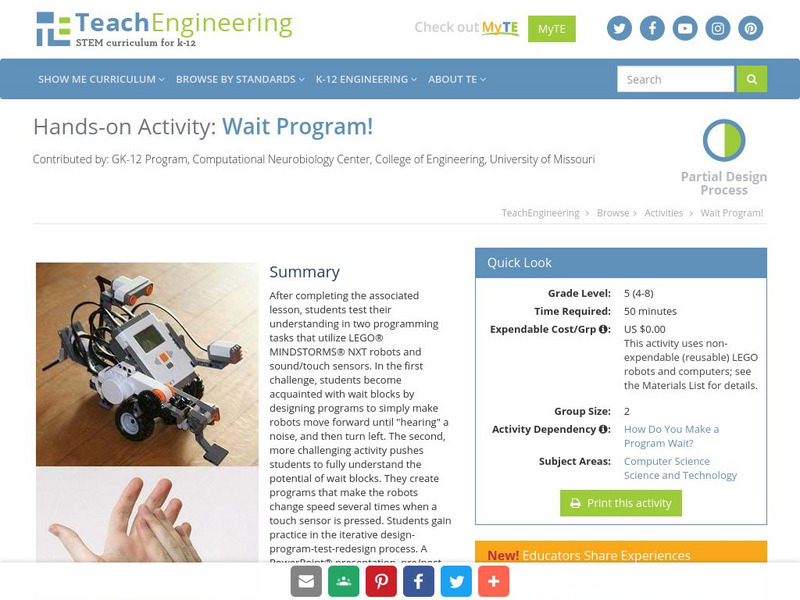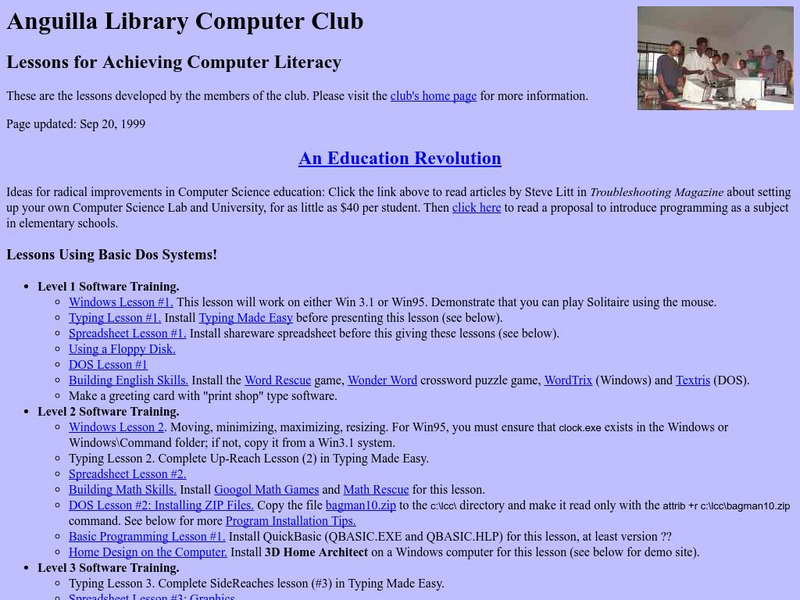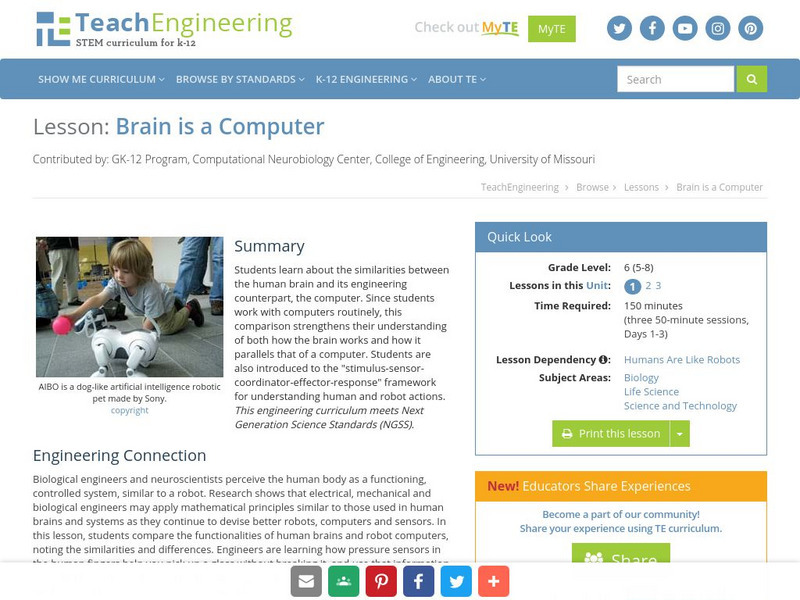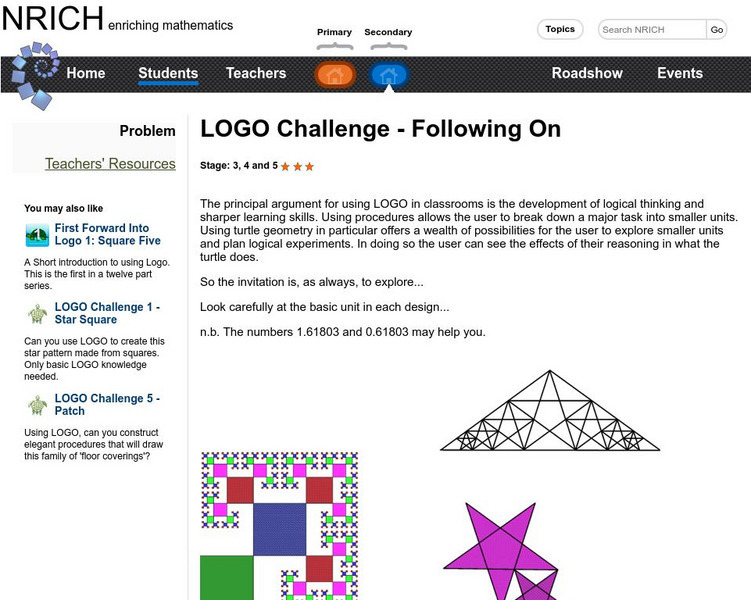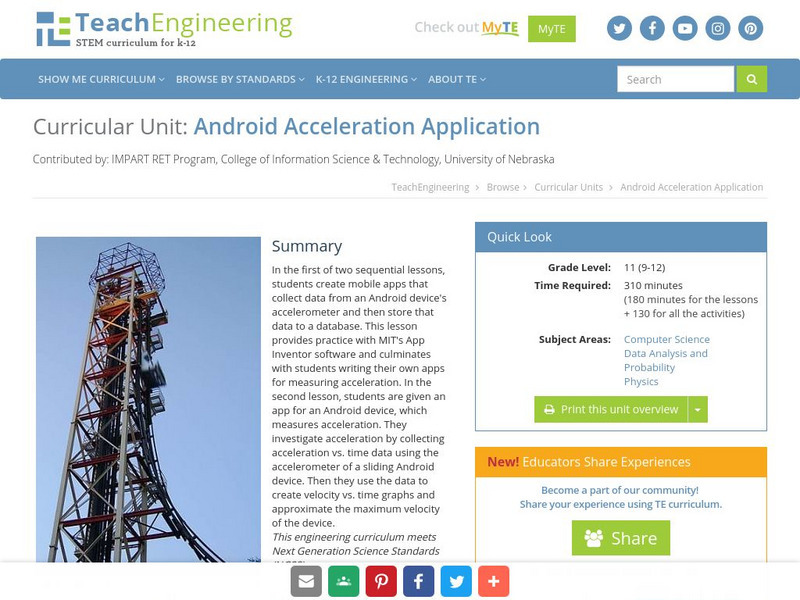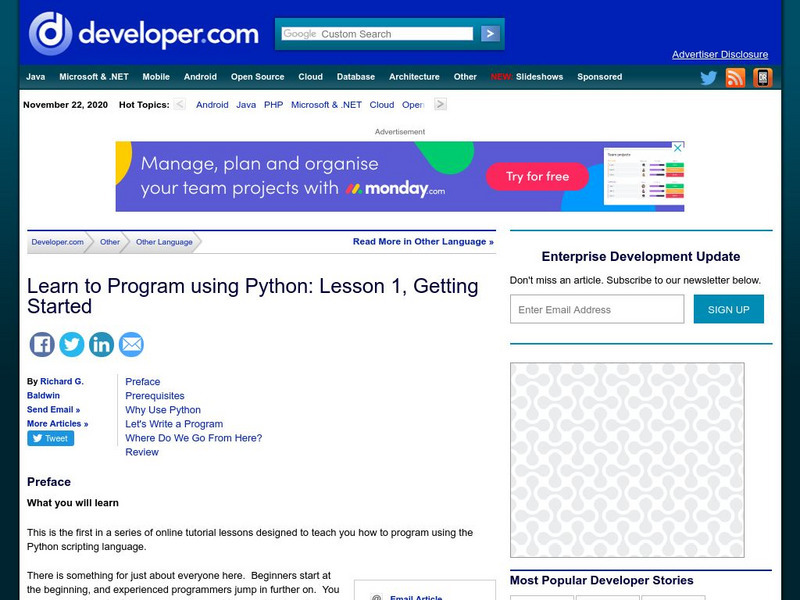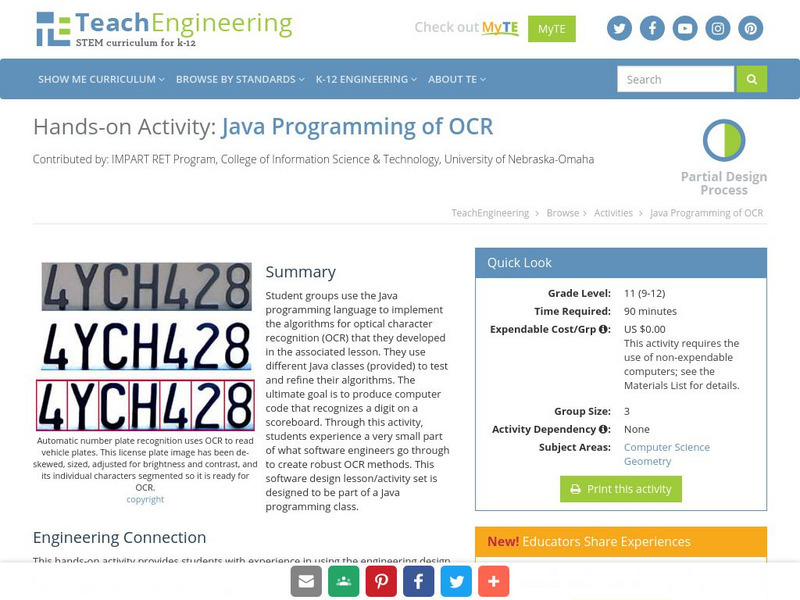TeachEngineering
Teach Engineering: What Is a Computer Program?
Through four lesson and four activities, students are introduced to the logic behind programming using LEGO MINDSTORMS NXT robots.
Other
Robotc: Thinking About Programming: Programmer & Machine [Pdf]
In this lesson, students learn about the roles of the programmer and the robot, and how the two need to work together in order to accomplish their goal. Students also understand logic behind the robot's actions, and break a big plan down...
TeachEngineering
Teach Engineering: What Is a Program?
Using a few blindfolds and a simple taped floor maze exercise, students come to understand that computers rely completely upon instructions given in programs and thus programs must be comprehensive and thorough. Then students learn to...
TeachEngineering
Teach Engineering: How Do You Make a Program Wait?
Building on the programming basics learned so far in a corresponding Robotics unit, students learn how to program using sensors rather than by specifying exact durations. Working with the LEGO MINDSTORMS NXT robots and software, they...
TeachEngineering
Teach Engineering: Program Analysis Using App Inventor
In computer science, program analysis is used to determine the behavior of computer programs. Flow charts are an important tool for understanding how programs work by tracing control flow. Control flow is a graphical representation of...
TeachEngineering
Teach Engineering: Wait Program!
After completing an associated lesson, students test their understanding in two programming tasks that utilize LEGO MINDSTORMS NXT robots and sound/touch sensors. Students gain practice in the iterative design-program-test-redesign process.
Other
Anguilla Library: Lessons for Achieving Computer Literacy
This site presents lessons on software usage by members of a computer club. Lessons include Basic Dos Systems, Windows, Spreadsheets, Basic Programming, and more.
TeachEngineering
Teach Engineering: Python Calculus
Students analyze a cartoon of a Rube Goldberg machine and a Python programming language script to practice engineering analysis. This exercise enables students to see the parallels between a more traditional mechanical engineering design...
University of Canterbury
University of Canterbury: Cs Unplugged: Primary Enrichment Program [Pdf]
This unit introduces students to some of the building blocks of how computers work without using a computer at all. The lessons keep students actively involved in communication, problem solving, creativity, and thinking skills in...
Khan Academy
Khan Academy: Teaching Guide: Intro to Js Interactive Programs
A teaching guide for the Intro to JS lesson on Interactive programs.
TeachEngineering
Teach Engineering: Brain Is a Computer
Students learn about the similarities between the human brain and its engineering counterpart, the computer. Since students work with computers routinely, this comparison strengthens their understanding of both how the brain works and...
Other
Jan's Web Work: Jan's Illustrated Computer Literacy 101
Illustrated and interactive web tutorial that guides learners through to achieving strong, basic computer knowledge. The tutorial is broken into chapters with interactive quizzes.
University of Cambridge
University of Cambridge: Nrich: Beginning Logo Programming
A helpful compilation of lessons sequenced to help you get started learning the Logo programming language. Logo is used for writing procedures and superprocedures. It sharpens your problem-solving, sequencing, and geometry skills.
Code.org
Code.org: Cs Fundamentals: Programming With Angry Birds
In this instructional activity, students will develop programming and debugging skills on a computer platform. The block-based format of these puzzles help students learn about sequence and concepts, without having to worry about...
TeachEngineering
Teach Engineering: Android Acceleration Application
This unit includes two sequential lessons. In the first, students create mobile apps that collect data from an Android device's accelerometer and then store that data to a database. This lesson provides practice with MIT's App Inventor...
Other
Learn to Program Using Python
A beginner's tutorial for learning how to use the Python scripting language.
TeachEngineering
Teach Engineering: Our Bodies Have Computers and Sensors
Students learn about the human body's system components, specifically its sensory systems, nervous system and brain, while comparing them to robot system components, such as sensors and computers. The unit's life sciences-to-engineering...
TeachEngineering
Teach Engineering: Java Programming of Ocr
Student groups use the Java programming language to implement the algorithms for optical character recognition (OCR) that they developed in the associated lesson. The ultimate goal is to produce computer code that recognizes a digit on a...
Code.org
Code.org: Cs Fundamentals: Debugging a Maze
Students in your class might become frustrated with this lesson because of the essence of debugging. Debugging is a concept that is very important to computer programming. Computer scientists have to get really good at facing the bugs in...
Better Lesson
Better Lesson: Bar Graph Activity
The students will be collecting data from other students to represent in a bar graph. If available, they can then use a computer program called Bar Grapher tool to show their data with a different layout.
TeachEngineering
Teach Engineering: Storing Android Accelerometer Data: App Design
Young scholars work through an online tutorial on MIT's App Inventor to learn how to create Android applications. Using those skills, they create their own applications and use them to collect data from an Android device accelerometer...
TeachEngineering
Teach Engineering: How Do You Make Loops and Switches?
Students learn how to program using loops and switches. Using the LEGO MINDSTORMS NXT robots, sensors and software, student pairs perform three mini programming activities using loops and switches individually, and then combined.
TeachEngineering
Teach Engineering: How Does a Touch Sensor Work?
Students look at human senses and their electronic imitators, with special focus on the skin and touch sensors. They have a chance to handle and get familiar with the LEGO touch sensor, including programming LEGO MINDSTORMS NXT robots to...
TeachEngineering
Teach Engineering: How Does a Sound Sensor Work?
Students learn about how sound sensors work, reinforcing their similarities to the human sense of hearing. This instructional activity and its associated activity enable students to appreciate how robots can take sensor input and use it...

![Robotc: Thinking About Programming: Programmer & Machine [Pdf] Article Robotc: Thinking About Programming: Programmer & Machine [Pdf] Article](https://static.lp.lexp.cloud/images/attachment_defaults/resource/large/FPO-knovation.png)

